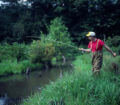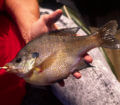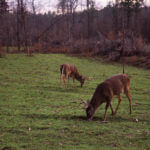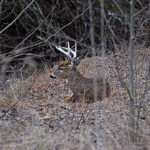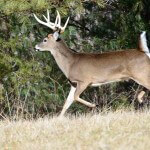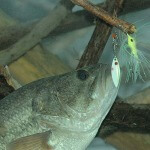John’s Note: The most-overlooked bream in America today are those living in beaver ponds. Often bodies of water are created when beavers build dams and stop the water flow from a drainage or flooded areas. Most fishermen don’t realize these ponds are there. And, the ones who do know are afraid to fish for bream in those places. Some of these fish will be stunted in their growth, while others will be whoppers. The world’s record bream as recognized by the International Game & Fish Association and the Freshwater Fishing Hall of Fame is a 5-pound, 7-ounce redear sunfish caught by Amos M. Gay on November 6, 1998, in the Diversion Canal in South Carolina. There are two records pending – a 5-pound, 8.8-ounce caught in May, 2011, from Lake Havasu in Arizona and a 5-pound, 12.8-ounce redear caught in February, 2014, also at Lake Havasu, Arizona. Native to eastern North America, today bream are found all across the U.S., inhabiting ponds, lakes and other bodies of quiet, shallow water with vegetation and fallen limbs and logs. Bream have been introduced successfully too in Europe, South Africa, Zimbabwe, Asia and South America, but are considered trash fish in Japan and Germany. Even more exciting is the fact that bream will bite year-round, always fighting hard.
 Food is abundant in most beaver ponds. In addition to small minnows, there are usually insects, grubs, caterpillars, maggots, insect larvae, crayfishes, leeches, snails and worms that fall into and are present in the water and are eaten by the bream. My favorite baits are pretty much the old standbys for catching bream – red worms, crickets, golden mealy worms and catalpa worms all will pay off. Bream feed by getting very close to their prey and using a suction system to accelerate water and the prey into their mouths and then use gill rakers and bands of small teeth to ingest their food. In most ponds, the big bream will begin to bed in May and June and may bed all summer long. The 1-2 foot-deep water is where you primarily will find the bream, usually around a shallow water stump. You may not be able to see the bream, but it often will be possible to see a disturbance on the water’s surface as the fish moves about. For this reason, I prefer not to use a cork or a lead when I’m fishing for these bedding bream. I let the bait hit the water softly and naturally fall to the bottom, so the bream is not spooked. Bream will hit human food too such as corn, and pieces of cheese, bread and hot dogs.
Food is abundant in most beaver ponds. In addition to small minnows, there are usually insects, grubs, caterpillars, maggots, insect larvae, crayfishes, leeches, snails and worms that fall into and are present in the water and are eaten by the bream. My favorite baits are pretty much the old standbys for catching bream – red worms, crickets, golden mealy worms and catalpa worms all will pay off. Bream feed by getting very close to their prey and using a suction system to accelerate water and the prey into their mouths and then use gill rakers and bands of small teeth to ingest their food. In most ponds, the big bream will begin to bed in May and June and may bed all summer long. The 1-2 foot-deep water is where you primarily will find the bream, usually around a shallow water stump. You may not be able to see the bream, but it often will be possible to see a disturbance on the water’s surface as the fish moves about. For this reason, I prefer not to use a cork or a lead when I’m fishing for these bedding bream. I let the bait hit the water softly and naturally fall to the bottom, so the bream is not spooked. Bream will hit human food too such as corn, and pieces of cheese, bread and hot dogs.
Wade fishing is a good method to employ when hunting beaver pond bream. Wader boots, chest-type waders or old tennis shoes all work well. I also like to wade float in my belly boat – a camouflaged tube from Bass Pro Shops (http://www.basspro.com/) that allows me to carry my lures, extra tackle and other necessities with me. Wading these ponds gives you the advantages of getting close to the fish and allows you to penetrate areas that conventional boats may not be able to reach. Wading also lets you hide from the bream and take more than you can if the fish spot you. When I first started wade fishing, a pair of cheap tennis shoes was all I had. So, I stayed wet most of the day. At lunch and supper, I also had leeches to pull from my hide. But now I strongly advocate wearing waders for beaver pond bream.
Moving very quietly and slowly through the water, I try to cause as little disturbance on the water as possible. This tactic often gets me to within 6-8 feet of bedding fish. An angler often can find bream bedding next to a big tree. I try to get to the back side of the tree and swing my bait to the front of the tree. I never approach bedding bream head-on. Even though the water may look like yesterday’s coffee, bream always seem to be able to see unusually well. So, I hide from them. I feel the less you can do to spook the bream, the more likely you are to catch them.
 When I take a nice fish for the stringer, I’ll generally move three or four steps back from my tree, string the bream and leave the stringer tied to a branch away from my fishing spot. Some anglers prefer to have the convenience of having the stringer tied to themselves. Of course bream on a stringer will not stay still. I believe they often spook the fish I am close enough to catch.
When I take a nice fish for the stringer, I’ll generally move three or four steps back from my tree, string the bream and leave the stringer tied to a branch away from my fishing spot. Some anglers prefer to have the convenience of having the stringer tied to themselves. Of course bream on a stringer will not stay still. I believe they often spook the fish I am close enough to catch.
For close wade fishing, I like B‘n’M’s BreamBuster BB9 pole (https://www.bnmpoles.com). This 9 foot, black, fiberglass telescopic pole is collapsible, strong and full of action. Since the pole is segmented and yet in one piece, it is only about 2-feet long when it is telescoped down. The BreamBuster is easy to carry through the woods and swamps. The black color of the pole makes it hard for fish to see. The pole has the muscle to bring a bream out of heavy cover and yet is flexible enough to provide a lot of fun fishing. Remember to always fish with a small hook, due to the size of a bream’s mouth.
To learn more about fishing, get John E. Phillips’ eBooks and print books at www.barnesandnoble.com and www.amazon.com/author/johnephillips.

